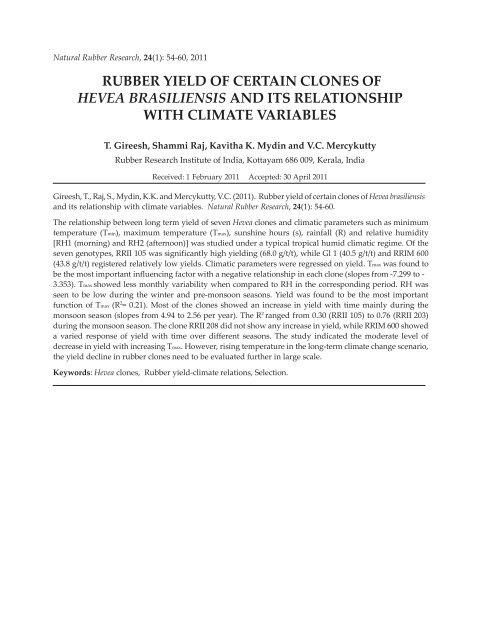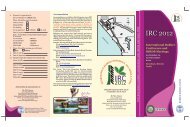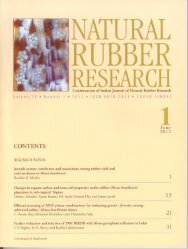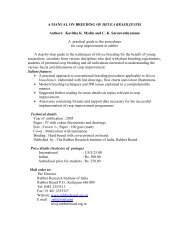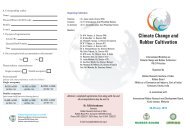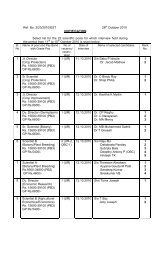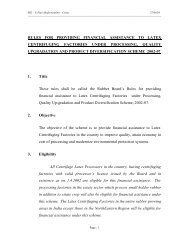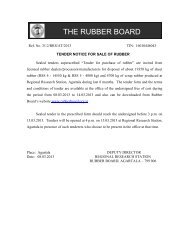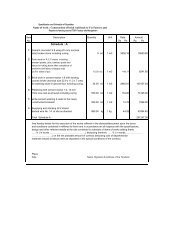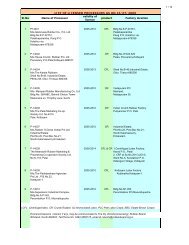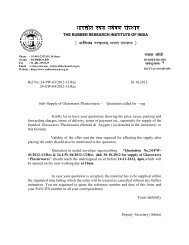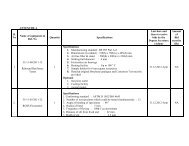to read the publication - Rubber Board
to read the publication - Rubber Board
to read the publication - Rubber Board
Create successful ePaper yourself
Turn your PDF publications into a flip-book with our unique Google optimized e-Paper software.
Natural <strong>Rubber</strong> Research, 24(1): 54-60, 2011<br />
RUBBER YIELD OF CERTAIN CLONES OF<br />
HEVEA BRASILIENSIS AND ITS RELATIONSHIP<br />
WITH CLIMATE VARIABLES<br />
T. Gireesh, Shammi Raj, Kavitha K. Mydin and V.C. Mercykutty<br />
<strong>Rubber</strong> Research Institute of India, Kottayam 686 009, Kerala, India<br />
Received: 1 February 2011 Accepted: 30 April 2011<br />
Gireesh, T., Raj, S., Mydin, K.K. and Mercykutty, V.C. (2011). <strong>Rubber</strong> yield of certain clones of Hevea brasiliensis<br />
and its relationship with climate variables. Natural <strong>Rubber</strong> Research, 24(1): 54-60.<br />
The relationship between long term yield of seven Hevea clones and climatic parameters such as minimum<br />
temperature (Tmin), maximum temperature (Tmax), sunshine hours (s), rainfall (R) and relative humidity<br />
[RH1 (morning) and RH2 (afternoon)] was studied under a typical tropical humid climatic regime. Of <strong>the</strong><br />
seven genotypes, RRII 105 was significantly high yielding (68.0 g/t/t), while Gl 1 (40.5 g/t/t) and RRIM 600<br />
(43.8 g/t/t) registered relatively low yields. Climatic parameters were regressed on yield. Tmax was found <strong>to</strong><br />
be <strong>the</strong> most important influencing fac<strong>to</strong>r with a negative relationship in each clone (slopes from -7.299 <strong>to</strong> -<br />
3.353). Tmax showed less monthly variability when compared <strong>to</strong> RH in <strong>the</strong> corresponding period. RH was<br />
seen <strong>to</strong> be low during <strong>the</strong> winter and pre-monsoon seasons. Yield was found <strong>to</strong> be <strong>the</strong> most important<br />
function of Tmax (R 2 = 0.21). Most of <strong>the</strong> clones showed an increase in yield with time mainly during <strong>the</strong><br />
monsoon season (slopes from 4.94 <strong>to</strong> 2.56 per year). The R 2 ranged from 0.30 (RRII 105) <strong>to</strong> 0.76 (RRII 203)<br />
during <strong>the</strong> monsoon season. The clone RRII 208 did not show any increase in yield, while RRIM 600 showed<br />
a varied response of yield with time over different seasons. The study indicated <strong>the</strong> moderate level of<br />
decrease in yield with increasing Tmax. However, rising temperature in <strong>the</strong> long-term climate change scenario,<br />
<strong>the</strong> yield decline in rubber clones need <strong>to</strong> be evaluated fur<strong>the</strong>r in large scale.<br />
Keywords: Hevea clones, <strong>Rubber</strong> yield-climate relations, Selection.


